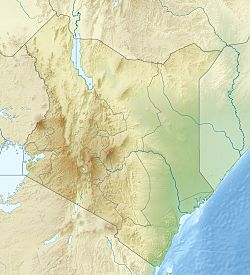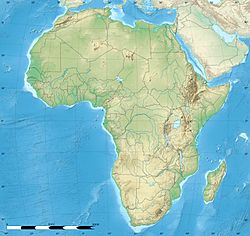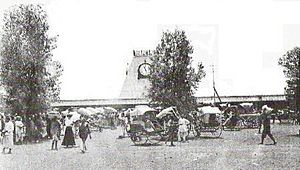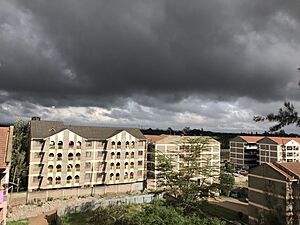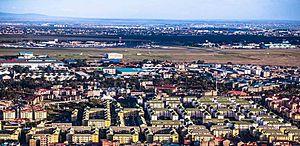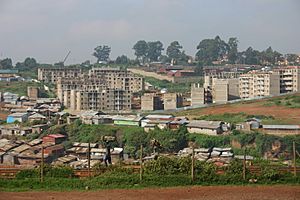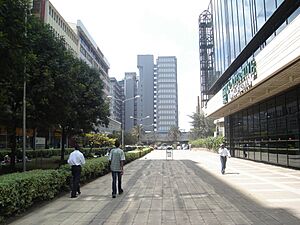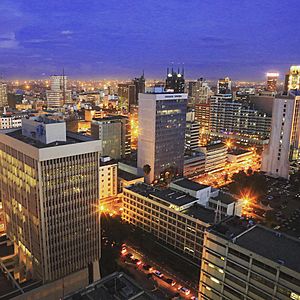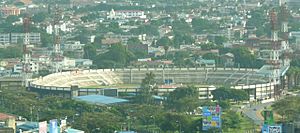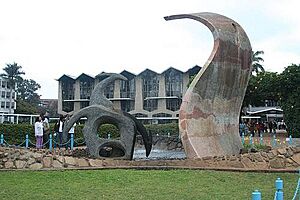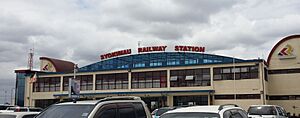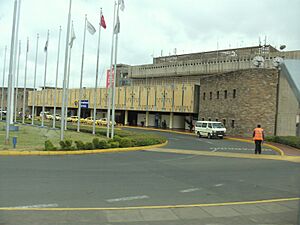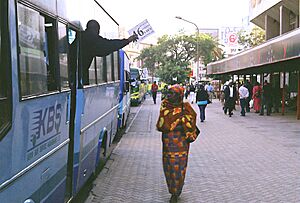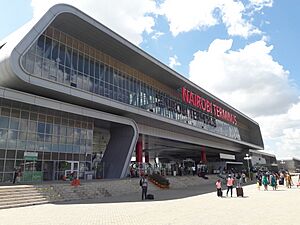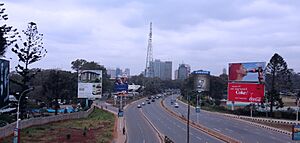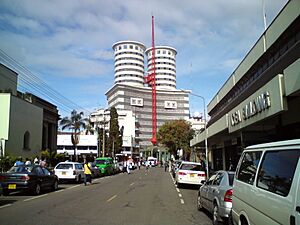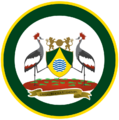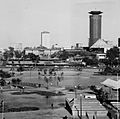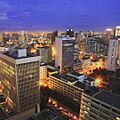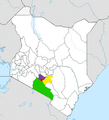Nairobi facts for kids
Quick facts for kids
Nairobi
|
|||
|---|---|---|---|
|
Consolidated city-county
|
|||
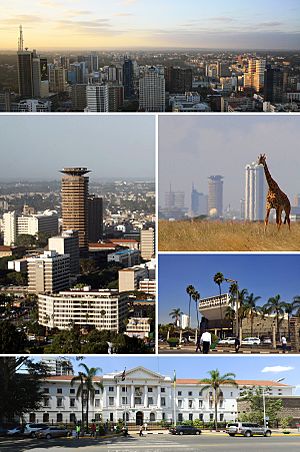
Clockwise from top: central business district; a giraffe walking in Nairobi National Park; Parliament of Kenya; Nairobi City Hall; and the Kenyatta International Convention Centre
|
|||
|
|||
| Nickname(s):
"The Green City under the Sun"
|
|||
| Country | |||
| County | Nairobi City | ||
| Founded | 1899 | ||
| Sub-counties |
List
Dagoretti
Embakasi Lang'ata Kamukunji Kasarani Kibra Makadara Mathare Njiru Starehe Westlands |
||
| Government | |||
| • Body | Nairobi City County | ||
| Area | |||
| • Total | 696.1 km2 (268.8 sq mi) | ||
| Elevation | 1,795 m (5,889 ft) | ||
| Population
(2019)
|
|||
| • Total | 4,397,073 | ||
| • Estimate
(2024)
|
4,828,000 | ||
| • Density | 6,316.7/km2 (16,360.2/sq mi) | ||
| Demonym(s) | Nairobian | ||
| GDP (PPP) | |||
| • Total | City |
||
| • Per Capita | |||
| GDP (nominal) | |||
| • Total | City |
||
| • Per Capita | |||
| Time zone | UTC+03:00 (EAT) | ||
| Area code(s) | 020 | ||
| HDI (2022) | 0.771high | ||
Nairobi is the capital and largest city of Kenya. It is located in the south-central part of Kenya. The city sits high up, about 1,795 meters (5,889 feet) above sea level. Its name comes from the Maasai language phrase Enkare Nyrobi, which means 'place of cool waters'. This name refers to the Nairobi River that flows through the city. In 2019, Nairobi had a population of 4,397,073 people.
Nairobi is an important city for Kenya and for international organizations. It is home to the Kenyan Parliament and many Kenyan and international businesses. The United Nations Environment Programme (UN Environment) and the United Nations Office at Nairobi (UNON) have their main offices here. Nairobi is a major center for business and culture. The Nairobi Securities Exchange (NSE) is one of Africa's largest stock exchanges. It is also famous for the Nairobi National Park, where you can see wildlife right next to the city! Nairobi joined the UNESCO Global Network of Learning Cities in 2010.
Nairobi was started in 1899 by the British colonial government. It began as a railway stop on the Uganda - Kenya Railway. The location was chosen because it was high up, had a mild climate, and plenty of water. The town grew quickly and became the capital of Kenya in 1907, taking over from Mombasa. After Kenya became independent in 1963, Nairobi continued to be the capital. The city has grown into a modern place with many different people and a strong economy.
Contents
- History of Nairobi
- Geography of Nairobi
- Parks and Gardens in Nairobi
- Political Structure
- Nairobi's Economy
- Nairobi's Population
- Nairobi's Culture
- Sports in Nairobi
- Places of Worship
- Education in Nairobi
- Nairobi's Infrastructure
- Media in Nairobi
- Famous People from Nairobi
- Nairobi in Pop Culture
- Sister Cities
- Images for kids
- See also
History of Nairobi
How Nairobi Began
The area where Nairobi now stands was once a swampy land. It was used by the Maasai people (who raised cattle), the Kamba people (traders), and the Kikuyu people (farmers). The name Nairobi means 'cool waters' in the Maasai language, referring to a cold stream there.
When the Uganda Railway was being built, George Whitehouse, the chief engineer, chose this spot for a supply depot and camping ground. He liked it because it was high up, had a good climate, and enough water. It was also before a steep climb up the Limuru hills. Some officials worried it was too flat and wet, but Whitehouse's choice stuck.
In 1898, Arthur Church designed the first layout for the railway town. It had two main streets and areas for staff and Indian businesses. The railway arrived on May 30, 1899. Soon, Nairobi became the main office for the Ukamba province. The town grew fast, but faced challenges like malaria. In the early 1900s, a fire and an outbreak of Bubonic plague led to parts of the town being rebuilt.
Between 1902 and 1910, Nairobi's population grew from 5,000 to 16,000. It became important for government work and tourism, especially for big game hunting. In 1907, Nairobi officially became the capital of the East Africa Protectorate. By 1919, it was declared a municipality, which means it could govern itself more.
Nairobi's Growth and Modernization
By 1921, Nairobi had 24,000 residents, with about half being native Africans. As more Africans moved to the city, it created new challenges for planning. After World War II, the city continued to expand. This led to tensions, especially with the local Maasai and Kikuyu people. These tensions were part of the events that led to Kenya gaining independence in 1963.
After Kenya became independent in 1963, Nairobi remained the capital. Its fast growth put pressure on things like electricity and water supply.
On September 11, 1973, the Kenyatta International Convention Centre (KICC) opened. This 28-story building was designed by Karl Henrik Nøstvik and David Mutiso. It was built using local materials and designed to be eco-friendly with natural light and air. It has the largest meeting halls in East and Central Africa.
In 1972, the World Bank helped fund a big expansion of the Nairobi Airport, now called Jomo Kenyatta International Airport. This included new terminals, taxiways, and roads. The new terminal opened on March 14, 1978. The airport was later renamed after Kenya's first president, Jomo Kenyatta.
The Giraffe Centre, a special place for animals on the edge of Nairobi, opened in 1983. It helps protect the endangered Rothschild's giraffe.
In August 1998, a bombing occurred at the United States Embassy in downtown Nairobi. Today, the site is a memorial park.
Nairobi in the 21st Century
On October 20, 2011, a statue was unveiled in Nairobi to remember Tom Mboya, an important Kenyan politician.
On November 9, 2012, President Mwai Kibaki opened the Thika Superhighway. This huge project, which cost KES 31 billion, expanded a four-lane road to eight lanes. It also added underpasses and flyovers to help reduce traffic.
On May 31, 2017, President Uhuru Kenyatta launched the Standard Gauge Railway. This railway connects Nairobi to Mombasa. It was mostly built with funding from China. A second part of the railway is being built to link Naivasha to the existing route and then to the Uganda border.
Nairobi has seen many big building projects recently. The Nairobi Expressway, finished in 2022, helps reduce traffic on Mombasa Road. The Green Park Bus Terminal, which started in 2021, is part of improving public transport. Also, new homes are being built under the Kenyan government's Affordable Housing Program to house the city's growing population.
Geography of Nairobi
Nairobi covers an area of about 696 square kilometers (269 square miles). It is located between the cities of Kampala and Mombasa. Because Nairobi is near the eastern edge of the Kenya Rift Valley, small earthquakes sometimes happen. The Ngong Hills, west of the city, are a noticeable natural feature. Mount Kenya is to the north, and Mount Kilimanjaro is to the south-east.
The Nairobi River and its smaller streams flow through Nairobi County. They join the larger River Athi on the eastern side of the county.
Nobel Peace Prize winner Wangari Maathai worked hard to protect the native Karura Forest in northern Nairobi. This forest was in danger of being replaced by buildings.
Nairobi's western suburbs stretch for about 20 kilometers (12 miles). The city center is around the City Square in the Central Business District. Important buildings like the Kenyan Parliament, the Holy Family Cathedral, Nairobi City Hall, and the Kenyatta International Convention Centre are all around this square.
Nairobi's Climate
Nairobi has a subtropical highland climate. Because it is 1,795 meters (5,889 feet) above sea level, evenings can be cool, especially in June and July when temperatures might drop to 9°C (48°F). The sunniest and warmest time of year is from December to March, with daytime temperatures around 28°C (82°F).
Nairobi has rainy seasons, but the rainfall is usually moderate. The cloudiest time is after the first rainy season, from May to September, when it's often overcast with light rain. Since Nairobi is close to the equator, the seasons don't change much. They are simply called the wet season and dry season. Sunrise and sunset times also stay similar throughout the year.
| Climate data for Nairobi (Jomo Kenyatta International Airport), elevation 1,615 m (5,299 ft), (1991–2020 normals, extremes 1961–1990, 1999–present) | |||||||||||||
|---|---|---|---|---|---|---|---|---|---|---|---|---|---|
| Month | Jan | Feb | Mar | Apr | May | Jun | Jul | Aug | Sep | Oct | Nov | Dec | Year |
| Record high °C (°F) | 32.2 (90.0) |
33.6 (92.5) |
32.5 (90.5) |
32.2 (90.0) |
32.4 (90.3) |
29.0 (84.2) |
29.4 (84.9) |
32.2 (90.0) |
32.5 (90.5) |
35.7 (96.3) |
32.2 (90.0) |
32.2 (90.0) |
35.7 (96.3) |
| Mean daily maximum °C (°F) | 26.9 (80.4) |
28.1 (82.6) |
28.3 (82.9) |
26.2 (79.2) |
24.9 (76.8) |
23.7 (74.7) |
23.6 (74.5) |
24.1 (75.4) |
26.3 (79.3) |
26.9 (80.4) |
25.3 (77.5) |
25.8 (78.4) |
25.8 (78.5) |
| Daily mean °C (°F) | 20.3 (68.5) |
20.9 (69.6) |
21.6 (70.9) |
20.7 (69.3) |
19.8 (67.6) |
18.5 (65.3) |
17.7 (63.9) |
18.2 (64.8) |
19.4 (66.9) |
20.4 (68.7) |
19.9 (67.8) |
19.7 (67.5) |
19.8 (67.6) |
| Mean daily minimum °C (°F) | 14.2 (57.6) |
14.1 (57.4) |
15.2 (59.4) |
15.6 (60.1) |
14.8 (58.6) |
13.1 (55.6) |
11.9 (53.4) |
12.5 (54.5) |
12.9 (55.2) |
14.6 (58.3) |
15.4 (59.7) |
14.8 (58.6) |
14.1 (57.4) |
| Record low °C (°F) | 3.2 (37.8) |
5.8 (42.4) |
7.2 (45.0) |
9.8 (49.6) |
6.3 (43.3) |
6.1 (43.0) |
2.8 (37.0) |
4.4 (39.9) |
4.2 (39.6) |
5.4 (41.7) |
7.8 (46.0) |
5.3 (41.5) |
2.8 (37.0) |
| Average precipitation mm (inches) | 57.8 (2.28) |
36.2 (1.43) |
74.7 (2.94) |
130.2 (5.13) |
101.9 (4.01) |
28.8 (1.13) |
10.9 (0.43) |
18.5 (0.73) |
16.9 (0.67) |
50.0 (1.97) |
130.6 (5.14) |
85.4 (3.36) |
741.9 (29.22) |
| Average precipitation days (≥ 1.0 mm) | 4.4 | 3.5 | 7.1 | 10.7 | 8.9 | 3.6 | 1.8 | 2.2 | 2.3 | 6.4 | 13.8 | 7.3 | 72 |
| Average relative humidity (%) | 69 | 63 | 66 | 77 | 79 | 76 | 74 | 71 | 67 | 67 | 77 | 76 | 72 |
| Mean monthly sunshine hours | 282.1 | 265.6 | 263.5 | 204.0 | 179.8 | 159.0 | 124.0 | 124.0 | 168.0 | 213.9 | 204.0 | 254.2 | 2,442.1 |
| Mean daily sunshine hours | 9.1 | 9.4 | 8.5 | 6.8 | 5.8 | 5.3 | 4.0 | 4.0 | 5.6 | 6.9 | 6.8 | 8.2 | 6.7 |
| Source 1: Deutscher Wetterdienst (humidity and sun 1961–1990) | |||||||||||||
| Source 2: Starlings Roost Weather | |||||||||||||
| Climate data for Nairobi (Dagoretti) 1961–1990, extremes 1955–1982 and 1984–present | |||||||||||||
|---|---|---|---|---|---|---|---|---|---|---|---|---|---|
| Month | Jan | Feb | Mar | Apr | May | Jun | Jul | Aug | Sep | Oct | Nov | Dec | Year |
| Record high °C (°F) | 34.8 (94.6) |
33.5 (92.3) |
32.9 (91.2) |
29.0 (84.2) |
26.8 (80.2) |
28.1 (82.6) |
32.7 (90.9) |
32.5 (90.5) |
30.0 (86.0) |
32.0 (89.6) |
37.9 (100.2) |
35.6 (96.1) |
37.9 (100.2) |
| Mean daily maximum °C (°F) | 25.5 (77.9) |
26.7 (80.1) |
27.7 (81.9) |
25.8 (78.4) |
23.5 (74.3) |
22.5 (72.5) |
22.0 (71.6) |
22.7 (72.9) |
25.0 (77.0) |
25.7 (78.3) |
24.0 (75.2) |
24.5 (76.1) |
24.6 (76.4) |
| Daily mean °C (°F) | 19.7 (67.5) |
20.2 (68.4) |
21.0 (69.8) |
19.5 (67.1) |
17.8 (64.0) |
16.3 (61.3) |
15.6 (60.1) |
15.9 (60.6) |
17.3 (63.1) |
18.5 (65.3) |
18.4 (65.1) |
18.1 (64.6) |
18.2 (64.7) |
| Mean daily minimum °C (°F) | 12.7 (54.9) |
12.7 (54.9) |
13.8 (56.8) |
14.0 (57.2) |
12.1 (53.8) |
10.0 (50.0) |
9.2 (48.6) |
9.1 (48.4) |
9.7 (49.5) |
11.3 (52.3) |
12.7 (54.9) |
11.7 (53.1) |
11.6 (52.9) |
| Record low °C (°F) | 3.3 (37.9) |
2.2 (36.0) |
6.7 (44.1) |
7.8 (46.0) |
7.9 (46.2) |
4.4 (39.9) |
1.1 (34.0) |
2.9 (37.2) |
3.9 (39.0) |
5.5 (41.9) |
6.7 (44.1) |
6.2 (43.2) |
1.1 (34.0) |
| Average precipitation mm (inches) | 58.3 (2.30) |
49.8 (1.96) |
92.2 (3.63) |
242.3 (9.54) |
189.5 (7.46) |
38.6 (1.52) |
17.6 (0.69) |
24.0 (0.94) |
31.2 (1.23) |
60.8 (2.39) |
149.6 (5.89) |
107.6 (4.24) |
1,061.5 (41.79) |
| Average precipitation days (≥ 1.0 mm) | 4 | 4 | 8 | 15 | 13 | 5 | 3 | 4 | 4 | 7 | 14 | 9 | 90 |
| Average relative humidity (%) | 60 | 56 | 62 | 71 | 73 | 73 | 73 | 71 | 64 | 63 | 71 | 66 | 67 |
| Mean monthly sunshine hours | 288.3 | 266.0 | 267.0 | 204.0 | 189.1 | 159.0 | 130.2 | 127.1 | 180.0 | 226.3 | 198.0 | 257.3 | 2,492.3 |
| Mean daily sunshine hours | 9.3 | 9.3 | 8.6 | 6.8 | 6.1 | 5.3 | 4.2 | 4.1 | 6.0 | 7.3 | 6.6 | 8.3 | 6.8 |
| Source 1: NOAA | |||||||||||||
| Source 2: Deutscher Wetterdienst (extremes from 1955 to 1982 and humidity, 1961–1990), Meteo Climat (extremes from 1984–present) | |||||||||||||
Nairobi's Metropolitan Area
Nairobi is part of the larger Greater Nairobi Metropolitan region. This area includes parts of 5 out of Kenya's 47 counties. Together, these counties produce about 40% of Kenya's total economic output (GDP). Nairobi County itself contributes 27.5% of the country's GDP.
Districts and Neighborhoods
Nairobi is divided into different areas called constituencies. Each constituency has a Member of Parliament. There are 17 constituencies in Nairobi.
Most of the wealthier neighborhoods are in the west and north-central parts of Nairobi. These areas were where many European settlers lived during colonial times. Examples include Karen, Langata, Lavington, Gigiri, and Muthaiga. However, some lower-income areas like Kangemi and Kawangware are also close by.
Middle-income neighborhoods are often found in north-central areas like Highridge and Parklands. They are also in the southwest and southeast, near Jomo Kenyatta International Airport. Some well-known middle-income areas include Pipeline, Donholm, Nairobi West, and Buru Buru.
Lower-income areas are mostly in eastern Nairobi. These include Umoja, Dandora, Kariobangi, and Kayole. Many Somali immigrants have settled in Eastleigh, which is sometimes called "Little Mogadishu".
Kibera: A Large Neighborhood
Kibera is a very large neighborhood in Nairobi. The Kenyan government states its population is around 185,777. However, other groups estimate the population to be much higher, between 500,000 and 1,000,000 people. Kibera is located west of Nairobi.
Parks and Gardens in Nairobi
Nairobi has many parks and green spaces. Much of the city has lots of trees and open green areas.
The most famous park is Uhuru Park. It is next to the central business district. Uhuru Park is a place for outdoor speeches and gatherings. Years ago, there was a plan to build a large building in the park. But Nobel Peace Prize winner Wangarĩ Maathai led a campaign that saved the park.
Central Park is right next to Uhuru Park. It has memorials for Jomo Kenyatta, Kenya's first president, and the Moi Monument. Both Uhuru Park and Central Park were recently improved. They now have water features, better restrooms, a skateboarding area, and walking paths. They also feature statues of local wildlife and beautiful gardens.
Jeevanjee Gardens is in the Central Business District. It is one of Nairobi's oldest public green spaces. It was created in the early 1900s by a businessman named Alibhai Mulla Jeevanjee.
The John Michuki Memorial Park is along the Nairobi River. It was reopened in August 2020 after being renovated. The park is named after former Cabinet Minister John Michuki, who helped clean up the Nairobi River.
Nairobi Arboretum, started in 1907, is a 30-hectare botanical reserve. It has over 350 types of trees and is used for both relaxation and research. It is near the State House.
Karura Forest is a nature reserve within the city. It has nature trails, picnic spots, caves, and waterfalls. It's a great place for birdwatching, with over 200 bird species. You might also see monkeys and bushbucks there.
Nairobi City Park is a large urban green space, over 60 hectares. It has one of the last remaining parts of the original forest that covered the region. The park is home to Sykes’ monkeys, many bird species, and native plants. It also has cemeteries for World War I and II veterans.
Oloolua Nature Trail is in Oloolua Forest in the Karen area. It's managed by the Kenya Institute of Primate Research. You can enjoy nature walks and bird watching here. It has a 37-meter deep natural cave, a waterfall, and a bamboo resting spot.
Ngong Road Forest Sanctuary has walking and jogging paths through tall trees. You can see various birds and sometimes Sykes monkeys. There's also a picnic site and a playground.
Langata Botanical Gardens is a private garden with many native trees, lawns, and a lagoon with fish.
Other private botanical gardens include Maarifa Park Botanical Garden and the Five Senses Botanical Gardens.
Nairobi Botanical Gardens are inside the National Museums of Kenya. They have themed sections, like the Children's Garden, which teaches about plants and habitats.
The August 7th Memorial Park is at the site of the 1998 US Embassy bombing. It is a peaceful green space.
Challenges for Public Spaces
Nairobi's original city plan from 1948 set aside 28% of the land for public spaces. However, due to fast population growth, many public spaces are now at risk. For example, City Park, which was once 150 acres, has lost about 50 acres to private buildings and illegal land use since the 1980s.
Political Structure
Nairobi is a full administrative county. Before 2013, Nairobi was one of Kenya's eight provinces. In 2010, with a new constitution, Nairobi became a county and a city-county. It is entirely urban. The Nairobi City Council was replaced by the Nairobi City County in March 2013.
Nairobi County has 17 constituencies. These are often named after residential areas.
Nairobi's Constituencies
Nairobi is divided into 17 constituencies and 85 wards.
| Constituency | Communities |
|---|---|
| Dagoretti North | Kilimani · Kawangware · Gatina · Kileleshwa · Kabiro |
| Dagoretti South | Mutu-ini · Ng'ando · Riruta · Uthiru/Ruthimitu · Waithaka |
| Lang'ata | Karen · Nairobi West · Mugumo-ini · South C · Nyayo Highrise · Otiende |
| Kibra | Laini Saba · Lindi · Makina · Woodley/Kenyatta Golf Course · Sarang'ombe |
| Kasarani | Clay City · Mwiki · Kasarani · Njiru · Ruai · Kamulu |
| Roysambu | Roysambu · Garden Estate · Ridgeways · Githurai · Kahawa West · Zimmermann · Kahawa |
| Ruaraka | Babadogo · Utalii · Mathare North · Lucky Summer · Korogocho |
| Embakasi Central | Kayole North · Kayole North Central · Kayole South · Komarock · Matopeni/Spring Valley |
| Embakasi East | Upper Savanna · Lower Savanna · Embakasi · Utawala · Mihang'o |
| Embakasi North | Kariobangi North · Dandora Area I · Dandora Area II · Dandora Area III · Dandora Area IV |
| Embakasi South | Imara Daima · Kwa Njenga · Kwa Reuben · Pipeline · Kware |
| Embakasi West | Umoja I · Umoja II · Mowlem · Kariobangi South |
| Kamukunji | Pumwani · Eastleigh North · Eastleigh South · Airbase · California |
| Makadara | Maringo/Hamza · Viwandani · Harambee · Makongeni · Mbotela · Bahati |
| Mathare | Hospital · Mabatini · Huruma · Ngei · Mlango Kubwa · Kiamaiko |
| Starehe | Nairobi Central · Ngara · Pangani · Ziwani/Kariokor · Landimawe · Nairobi South |
| Westlands | Kitisuru · Parklands/Highridge · Karura · Kangemi · Mountain View |
The Nairobi General Post Office (GPO) Postal code is 00100.
Nairobi's Economy
Nairobi is home to the Nairobi Securities Exchange (NSE), one of Africa's biggest stock exchanges. It is the fourth largest in Africa by trading activity.
Many international companies and organizations have their regional headquarters in Nairobi. Companies like General Electric, Google, Coca-Cola, and Cisco Systems have moved their African headquarters here. The United Nations Office at Nairobi hosts the main offices for UN Environment and UN-Habitat.
Some of Africa's largest companies are based in Nairobi. Safaricom, Kenya's biggest company, and KenGen, a large African stock company, are both here. Kenya Airways, Africa's fourth largest airline, uses Jomo Kenyatta International Airport as its main hub.
Nairobi is also a leader in financial technology (FinTech). Local tech companies like Craft Silicon and Jambo Pay offer innovative services.
Factories in Nairobi make clothes, textiles, building materials, food, drinks, and cigarettes. Many foreign companies, such as Goodyear Tire and Rubber Company, General Motors, and Toyota, have factories in and around the city.
Nairobi has a large tourist industry. It is both a place to visit and a central point for travel to other tourist spots.
Central Business District (CBD)
Nairobi's main business area is called the "CBD." It is shaped like a pentagon and includes many important buildings. These include the City Hall and Parliament Building. The city square is also in this area.
Most of the tall buildings here are headquarters for businesses. The 1998 US Embassy bombing happened in this district, which led to a new embassy being built in the suburbs.
In 2011, the city had about 4 million residents. The CBD was cleaned and repainted for the 2006 Afri-Cities summit. Iconic buildings like the Kenyatta International Convention Centre were also improved.
The CBD is bordered by Uhuru Park and Central Park to the southwest. The railway line from Mombasa to Kampala runs to the southeast.
Upper Hill Business Area
Two areas outside the CBD, Upper Hill and Westlands, are also growing with many companies and offices. Both are about 4 kilometers (2.5 miles) from the city center.
Companies like Citibank have moved to Upper Hill. In 2007, Coca-Cola started building its East and Central African headquarters there. This made Upper Hill a top choice for office space in Nairobi. The tallest office building in this area is UAP Tower, which is 163 meters (535 feet) high. The World Bank also has offices in Upper Hill.
Many new business parks are being built to meet the demand for office space, including the Nairobi Business Park.
Building Boom and New Projects
Nairobi is experiencing a big building boom. Many large real estate projects and skyscrapers are being built. These include the Pinnacle twin towers (314 m), Britam Tower (200 m), and Avic International Africa headquarters (176 m).
New shopping malls are also being constructed, such as Garden City Mall, Two Rivers Mall, and The Hub in Karen. High-class apartments are being built, like Le Mac towers in Westlands. New hotels are also rising, with Avic International building a 30-story hotel in Westlands.
| Pinnacle Towers (estimated completion in 2020) | 314 m (1,030 ft) |
| Britam Tower | 200 m (660 ft) |
| UAP Tower | 163 m (535 ft) |
| Times Tower | 140 m (460 ft) |
| Teleposta Towers | 120 m (390 ft) |
| Kenyatta International Conference Centre | 105 m (344 ft) |
| NSSF Building | 103 m (338 ft) |
| I&M Bank Tower | 100 m (330 ft) |
| Nyayo House | 84 m (276 ft) |
| Cooperative Bank House | 83 m (272 ft) |
| National Bank House | 82 m (269 ft) |
| Hazina Towers | 81 m (266 ft) |
| Rahimtulla Tower | 80 m (260 ft) |
Nairobi's Population
Population of Nairobi between 1906 and 2019

Nairobi has grown very quickly, faster than almost any other city in Africa. Even though it's one of the youngest cities in the region, it has become the second largest in the African Great Lakes area. In 2023, Nairobi's population was growing by about 2.09% each year. It is estimated that Nairobi's population will reach 5 million people in 2025.
Because of this fast growth, with many people moving to the city and a high birth rate, the economy sometimes struggles to keep up. Unemployment in the city is about 5.5%. This is mostly in the crowded, lower-income areas.
According to the 2019 Census, most people in Nairobi (89%) are Christian. Most of these belong to Protestant and Evangelical churches. Muslims make up a smaller but important group, at 7.6% of the population.
Here's how Nairobi's population has grown:
| Year | 2009 | 2019 | 2023 | 2030 |
|---|---|---|---|---|
| Population size | 3,138,372 | 4,397,073 | 4,677,677 | 5,212,500 |
Historical Population Data
| Year | 1969 | 1979 | 1989 | 1999 | 2009 | 2019 |
|---|---|---|---|---|---|---|
| Nairobi | 509,286 | 827,775 | 1,324,570 | 2,143,254 | 3,138,369 | 4,397,073 |
Nairobi's Culture
Nairobi is a mix of many different African cultures. As a big city, it is home to all the different tribes of Kenya. It also has many people who have moved from other African countries.
Nairobi has two fun nicknames. It's called "The Green City in the Sun" because of its many trees and warm weather. It's also known as the "Safari Capital of the World" because it's a main starting point for safari trips.
Literature and Film
Kwani? is Kenya's first literary journal, started by writers in Nairobi. Nairobi's publishing houses have also published books by famous Kenyan authors like Ngũgĩ wa Thiong'o.
Many filmmakers also work in Nairobi. Filmmaking is still growing in Kenya, but people like producer Njeri Karago are helping it develop.
One of the most famous books and films set in Nairobi is Out of Africa. The book was written by Karen Blixen, who lived in the Nairobi area from 1917 to 1931. The neighborhood where she lived, Karen, is named after her. The film Out of Africa (1985) won many awards. Its popularity led to the opening of the Karen Blixen Museum in Nairobi.
Nairobi is also the setting for many novels by Ngũgĩ wa Thiong'o, a leading Kenyan writer.
Nairobi has been the setting for several other American and British films. A large part of The Constant Gardener (2005) was filmed in the city. The story is about a British diplomat whose wife is murdered in Kenya. Much of the filming took place in the Kibera neighborhood.
Among the latest Kenyan actors in Hollywood is Lupita Nyong'o. Lupita won an Oscar for her role in the film 12 Years a Slave. She is the daughter of Kenyan politician Peter Anyang' Nyong'o.
Most new Hollywood films are shown in Nairobi's cinemas. There are also two drive-in cinemas.
In 2015 and 2016, Nairobi was a key location for the American TV series Sense8. In 2015, Nairobi was also featured in the British thriller film Eye in the Sky.
In 2017, a main character in the Spanish TV series Money Heist was given the code-name "Nairobi."
Food in Nairobi
Nairobi has many different kinds of restaurants. You can find nyama choma (roasted meat), which is a local favorite. There are also American fast food places like KFC, Subway, and Burger King. South African chains like Galito's are also popular.
Coffee shops that also serve food, like Artcaffe and Nairobi Java House, are very popular with the middle class. Traditional restaurants like K'osewe's and Amaica specialize in African dishes.
Nairobi has an annual Restaurant Week (NRW) in January and February. During this time, restaurants offer special dining deals at lower prices.
Music Scene
Nairobi is the heart of Kenya's music scene. Benga is a Kenyan music style that started in Nairobi. It mixes jazz with Luo music. Mugithi is another popular style from central Kenya. Many music videos by local artists are filmed in Nairobi.
In the 1970s, Nairobi became a major center for music in the African Great Lakes region. It became a hub for soukous music, which came from Congo. Many Congolese artists moved to Nairobi and became very successful.
More recently, Nairobi has become the center of the Kenyan hip hop scene. This music style is very popular with young people. Successful artists like Jua Cali and Nonini are based in Nairobi.
Nairobi has also become a center for EDM in Kenya. Many nightclubs play EDM, especially for younger generations. Gospel music is also very popular in Nairobi, as it is in the rest of Kenya.
The music group Sauti Sol performed for U.S. President Barack Obama when he visited Nairobi in 2015.
Sports in Nairobi
Nairobi is the main sports center in the African Great Lakes region. Important yearly events include the Safari Rally, the Safari Sevens rugby union tournament, and the Nairobi Marathon.
Sports Facilities
The top sports facility in Nairobi and Kenya is the Moi International Sports Centre in Kasarani. It was finished in 1987 and hosted the 1987 All Africa Games. The complex has a 60,000-seat stadium, a 5,000-seat gym, and a 2,000-seat swimming center.
The Nyayo National Stadium is Nairobi's second largest stadium, with a capacity of 30,000. It is mainly used for football and is known for hosting rugby events. It is close to the Central Business District.
Nairobi City Stadium is the city's oldest stadium, used for club football.
Nairobi Gymkhana is where the Kenyan cricket team plays. It was also a venue for the 2003 Cricket World Cup.
Ulinzi Sports Complex opened in 2022. It has a 7,500-seat capacity, an athletics track, training grounds, and an indoor arena.
Dandora Stadium, which opened in 2024, has a 4,000-seat capacity and hosts top national league football games.
The Talanta Sports Stadium, with a capacity of 60,000, is currently being built and is expected to be finished by February 2026.
Football
Football is the most popular sport in Nairobi. Many football clubs are based here, including Kenyan Premier League teams like Gor Mahia and A.F.C. Leopards Sports Club.
Kenya, along with Tanzania and Uganda, will host the 2025 CHAN competition. These three countries will also jointly host the 2027 AFCON football competition.
Golf
There are several golf courses near Nairobi. The oldest 18-hole course is the Royal Nairobi Golf Club, started in 1906. Other notable clubs include Windsor Golf Hotel and Country Club and Karen Country Club.
The Kenya Open golf tournament, part of the European Tour, takes place in Nairobi.
Equestrian Sports
The Ngong Racecourse is the main center for horse racing in Kenya. The Kenya Open Polo tournament is often held at the Nairobi Polo Club.
Basketball
Basketball is also popular in Nairobi, played in school and college leagues. Many young people in the city are fans of the American NBA.
Marathons
Nairobi often hosts several marathons, including the Nairobi City Marathon and the Standard Chartered Nairobi Marathon.
Places of Worship
Nairobi has many places of worship. Most are Christian churches, such as Roman Catholic Archdiocese of Nairobi (Catholic Church), Anglican Church of Kenya (Anglican), and Presbyterian Church of East Africa. There are also Muslim mosques, including Jamia Mosque.
Education in Nairobi
Most schools in Nairobi follow the Kenyan competence-based curriculum. Nairobi Innovation Week (NIW) is an annual event started in 2015. It is organized by the University of Nairobi and government agencies. It focuses on new ideas, partnerships, and helping new businesses grow.
Higher Education
Nairobi is home to several universities and colleges.
- The University of Nairobi is the largest and oldest university in Kenya. It started in 1956 and became an independent university in 1970. It has about 84,000 students.
- Kenyatta University is about 16 kilometers (10 miles) from Nairobi. It was chartered in 1985 and offers many courses, including medicine, engineering, and law. It has about 32,000 students.
- Strathmore University began in 1961. It became a university in 1993.
- United States International University – Nairobi started in 1969 and became an independent university in 2005.
- In 2005, The Aga Khan Hospital, Nairobi became a teaching hospital for health sciences.
- The Catholic University of Eastern Africa is in the Lang'ata area. It received its charter in 1992.
- The Technical University of Kenya (formerly Kenya Polytechnic) is the only technical university in the country. It offers technical degree courses in engineering and applied sciences.
- Other universities include KCA University, Pan African Christian University, Riara University, Multimedia University of Kenya, Daystar University, and Africa International University.
Many other universities also have smaller campuses in Nairobi. The Railways Training Institute, established in 1956, is also a notable higher education institution.
Nairobi's Infrastructure
Transport in Nairobi
Major plans are being put in place to reduce traffic in Nairobi. The completion of Thika Road has greatly improved the city's roads. Several projects, like the Syokimau Rail Station and the Eastern and Northern Bypasses, have been finished. Many more projects are still underway.
These transport improvements help reduce travel costs and increase trade. They also improve life in Northern Kenya and attract investments to the country.
Airports
Jomo Kenyatta International Airport (JKIA) is the largest airport in Kenya. In 2016, over 7 million passengers used JKIA. In February 2017, JKIA received a special status from the FAA, making it an even more important aviation hub in the region.
Wilson Airport is a smaller airport for general aviation, mostly handling propeller planes.
Moi Air Base is a military airport. In the past, it was used as a landing strip for early airlines.
Matatu Public Transport
Matatus are the most common way to get around Nairobi using public transport. Matatus are privately owned minibuses that usually carry 14 to 33 passengers. They operate within Nairobi, its suburbs, and to other towns. Each matatu has its route printed on a yellow stripe on its side.
In 2004, a law required all matatus to have seat belts and speed governors. At first, matatu operators were unhappy, but they eventually made the changes. Matatus are now limited to 80 km/h (50 mph).
In November 2014, President Uhuru Kenyatta allowed matatus to keep their colorful designs. Matatus in Nairobi are known for their bright paint schemes, often showing favorite football teams or hip hop artists. They are also known for sometimes having safety issues due to overcrowding and fast driving. To attract customers, many have powerful sound systems and TV screens.
Buses
Buses are becoming more common in Nairobi. Some even offer free WiFi. There are four main bus companies: Kenya Bus Service (KBS), Citi Hoppa, Compliant MOA, and Double M. Citi Hoppa buses are green, Double M buses are purple, and KBS buses are blue.
Companies like Easy Coach and Guardian Angel offer scheduled bus services to other cities and towns.
A Bus rapid transit (BRT) system started operating in July 2022. It uses 100 large buses along Thika Road. The first phase will expand the BRT line from Ruiru to Kenyatta National Hospital. A second phase will extend the line further.
Trains
Nairobi was founded as a railway town. The main office of Kenya Railways (KR) is still at Nairobi railway station, near the city center. The railway line runs through Nairobi, connecting Mombasa to Kampala. It is mainly used for moving goods. Some morning and evening commuter trains connect the city center with the suburbs.
The new Mombasa–Nairobi Standard Gauge Railway connects Mombasa and Nairobi. This new railway has largely replaced the older one. The Nairobi Terminus is located at Syokimau, about 20 km (12 miles) from the city center. Passengers arriving from Mombasa are transferred to the CBD using the older trains.
Roads
Two major African road routes pass through Nairobi: the Cairo-Cape Town Highway and the Lagos-Mombasa Highway. Nairobi is connected by highways to Mombasa, Kampala, and Arusha. These roads help ease daily traffic. Most roads are paved and have signs. The city is connected to Jomo Kenyatta International Airport by the Mombasa Highway.
Highways connect Nairobi to other major towns like Mombasa, Eldoret, and Kisumu.
Nairobi is currently undergoing major road construction to improve its transport network. New roads, flyovers, and bridges are being built to handle high traffic levels. This is a key part of Kenya's Vision 2030 plan. Most roads are now well-lit and have good signage.
In 2020, construction began on The Nairobi Expressway. This is a 27 km (17 mile) toll road that connects Mulolongo to Westlands, passing through the CBD. It helps travelers get to Jomo Kenyatta International Airport faster by avoiding heavy traffic. The road has an 11.025 km (6.85 mile) elevated section. It opened to the public in May 2022.
Water Supply and Sanitation
Most of Nairobi's piped water (94%) comes from rivers and reservoirs in the Aberdare Range north of the city. The Thika Dam reservoir is the most important source. About 40% of the water is lost before it reaches homes. Only 40% of homes with water connections get water all the time. People living in informal settlements often get water from water kiosks and pay more for it.
Housing in Nairobi
Nairobi has many different housing options, including privately owned homes, rented apartments, and houses on mortgage. While many wealthy Kenyans live in Nairobi, most residents have average or low incomes. It is estimated that half of the population lives in informal settlements, which cover only 5% of the city's area. These settlements have grown due to people moving to the city, poor city planning, and other factors.
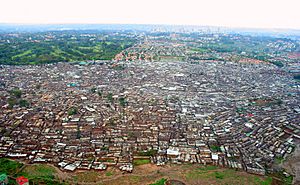
Kibera is one of the largest informal settlements in Africa, located west of Nairobi. The name Kibera comes from a Nubian word meaning "forest" or "jungle." Other notable informal settlements include Mathare and Korogocho. In total, 66 areas in Nairobi are considered informal settlements.
Many Nairobi residents who do not live in informal settlements have good housing. Large houses can be found in wealthy neighborhoods, especially in western Nairobi. These include Gigiri, Muthaiga, Langata, and Karen. Other middle and high-income areas include Parklands, Westlands, and Lavington.
To house the growing middle class, many new apartments and housing developments are being built. A notable development is Greenpark, located at Athi River, about 25 km (16 miles) from Nairobi's CBD. This development includes over 5,000 houses, villas, and apartments, along with shops and leisure facilities. Many developments in the city are designed for families. Eastlands also has many middle-class areas like South C, South B, and Buru Buru.
Media in Nairobi
Nairobi is home to most of Kenya's news and media organizations. The city has the region's largest newspapers: the Daily Nation and The Standard. These newspapers are published in English and cover news from Kenya and the region. People Daily is a leading free newspaper distributed in Nairobi.
Kenya Broadcasting Corporation, a state-run TV and radio station, is based in Nairobi. Kenya Television Network was Kenya's first private TV station. The Nation Media Group runs NTV, also based in Nairobi. There are many popular radio stations in Nairobi, including Citizen Radio, Capital FM, and KISS 100.
Several international media organizations have their regional headquarters in Nairobi. These include the BBC, CNN, Reuters, and the Associated Press. The Nairobi office of The New York Times is in Gigiri. The African headquarters of CCTV Africa is also in Nairobi.
Famous People from Nairobi
- Ishmael Awange (born 1989), basketball player
- Richard Dawkins (born 1941), British evolutionary biologist
- Chris Froome (born 1985), British professional cyclist and 4-time Tour de France winner
- Edi Gathegi (born 1979), actor
- Fena Gitu (born 1991), rapper
- Pamela Jelimo (born 1989), Olympic champion runner
- Wanuri Kahiu (born 1980), film director and author
- McDonald Mariga Wanyama, retired footballer
- Victor Wanyama (born 1991), footballer
Nairobi in Pop Culture
Rise and Fall of Idi Amin, a 1981 film, shows Nairobi's role in opposing the Ugandan dictator Idi Amin. It includes how Tel Aviv and Nairobi worked together during Operation Entebbe.
In 2012, the Kenyan film Nairobi Half Life was released. It was the first time Kenya submitted a film for the Academy Award for Best Foreign Language Film.
The character Ágata Jiménez in the Netflix series Money Heist is nicknamed "Nairobi." She is a main character known for managing the group's operations.
Sister Cities
Nairobi is connected with these cities around the world:
 Addis Ababa, Ethiopia
Addis Ababa, Ethiopia Cape Town, South Africa
Cape Town, South Africa Denver, United States
Denver, United States Kunming, China
Kunming, China Lowell, United States
Lowell, United States Raleigh, United States
Raleigh, United States São Luís, Brazil
São Luís, Brazil
Images for kids
-
Clockwise from top: central business district; a giraffe walking in Nairobi National Park; Parliament of Kenya; Nairobi City Hall; and the Kenyatta International Convention Centre
-
A giraffe at Nairobi National Park, with Nairobi's skyline in background
-
View of Kibera, Nairobi
See also
 In Spanish: Nairobi para niños
In Spanish: Nairobi para niños




